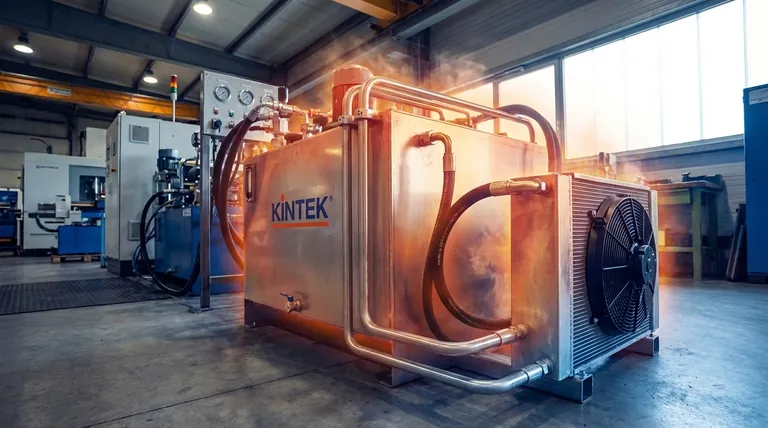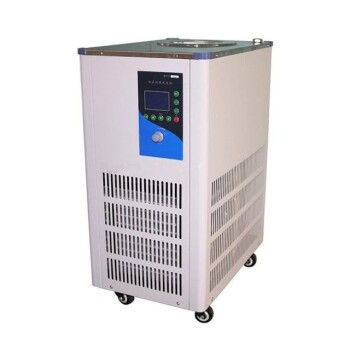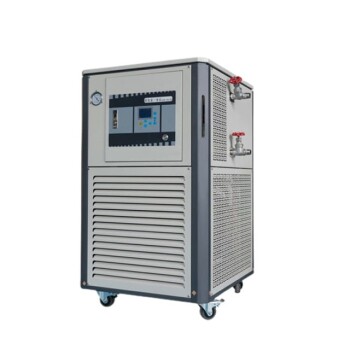In short, the heat generated in a hydraulic system is primarily absorbed and dissipated through the process of convection and radiation from the surfaces of its components. The single most important component for this passive cooling is the hydraulic reservoir (tank), followed by all the tubing, hoses, and actuators that make up the system. When this is insufficient, a dedicated heat exchanger is used.
Heat in a hydraulic system is an unavoidable byproduct of inefficiency. Understanding thermal management is not about eliminating heat, but about achieving a stable equilibrium where the rate of heat generation is balanced by the rate of heat dissipation, either naturally or with active cooling.

Where Hydraulic Heat Originates
Before discussing how heat is removed, it's critical to understand why it's generated. All heat in a hydraulic system is a conversion of mechanical or pressure energy into thermal energy due to inefficiency.
The Inevitable Cost of Work: Pressure Drops
The number one source of heat is the pressure drop of fluid flowing through the system without performing useful work.
Every time fluid is forced through an orifice, a partially open valve, or even a sharp bend in a pipe, its pressure drops. This lost pressure energy is converted directly into heat, which is absorbed by the fluid.
Friction: Mechanical and Fluid
The second major source is friction. This occurs in two forms.
Mechanical friction happens between moving parts, such as the pistons in a pump or the seals in a cylinder. Fluid friction is the internal resistance of the fluid itself (its viscosity) as it moves through pipes and hoses.
How Your System Naturally Sheds Heat
Your system is always trying to reach a thermal balance with its environment. This happens primarily through passive dissipation from its surfaces.
The Central Role of the Hydraulic Reservoir
The reservoir is the primary passive cooling component. As hot fluid returns to the tank, it has time to dwell.
The large surface area of the tank's walls allows this captured heat to dissipate into the surrounding air through convection (air movement over the surface) and radiation. A larger reservoir with good airflow around it can dissipate significantly more heat.
Dissipation from Tubing, Hoses, and Components
Every other component also contributes. The steel tubing, flexible hoses, and even the bodies of valves and cylinders have surface area.
As hot fluid flows through them, they heat up and radiate that thermal energy into the environment, acting as a distributed, albeit less efficient, radiator.
The Fluid as a Heat Transporter
It is essential to understand the role of the hydraulic fluid itself. The fluid is an excellent medium for absorbing and transporting heat, but it does not dissipate it on its own.
It picks up heat from a source (like a relief valve) and carries it to a location where it can be dissipated (like the reservoir). The total volume of fluid acts as a thermal buffer, but it's the system's components that ultimately get the heat out.
When Natural Cooling Isn't Enough: Active Heat Exchangers
For many high-demand or continuous-duty systems, passive cooling is insufficient. In these cases, a dedicated heat exchanger, or "oil cooler," is required.
Air-Cooled Heat Exchangers
This is the most common type. It functions like a car's radiator, where hot hydraulic fluid is passed through a core of finned tubes.
A fan, either electrically or hydraulically driven, forces ambient air across the fins, efficiently transferring heat from the oil to the air.
Water-Cooled Heat Exchangers
These are often more compact and efficient than air coolers but require a steady source of cool water.
Typically a "shell-and-tube" design, hot oil flows on one side of a series of conductive tubes while cool water flows on the other, allowing for very rapid and effective heat transfer.
Understanding the Trade-offs
Choosing a thermal management strategy requires balancing performance, cost, and complexity.
The Limits of Passive Cooling
Relying solely on natural dissipation is simple and cost-free, but its effectiveness is highly dependent on external factors.
A system that runs fine in a cool climate may overheat during a hot summer. Likewise, a system with poor airflow around the reservoir will dissipate much less heat.
The Cost and Complexity of Active Cooling
Adding a heat exchanger solves most overheating problems but introduces costs and new potential points of failure.
The cooler itself, plus its fan, motor, and associated plumbing, adds complexity and requires maintenance. It also consumes energy, slightly reducing overall system efficiency.
The Risk of Overcooling
It is also possible to overcool a hydraulic system, especially in cold climates. Cold oil has a much higher viscosity.
This can lead to sluggish performance, increased pressure drops (generating more heat!), and even pump cavitation on startup. Many systems use a thermostatic bypass valve to route fluid around the cooler until it reaches its optimal operating temperature.
A Strategy for Thermal Management
Use this framework to guide your decisions on hydraulic system cooling.
- If your primary focus is designing a new, efficient system: Prioritize minimizing unnecessary pressure drops from the start by using correctly sized valves, conductors, and efficient pumps. A well-designed system generates less heat to begin with.
- If your primary focus is fixing an existing overheating system: First, confirm all components (especially relief valves) are set and functioning correctly. Then, ensure the reservoir is clean and has adequate airflow. Only add a heat exchanger after confirming the base system is sound.
- If your primary focus is maximizing reliability and lifespan: Aim to maintain a stable fluid temperature within the manufacturer's recommended range (often 120-140°F / 50-60°C). This protects fluid integrity and extends the life of seals and components.
Effective thermal management is the foundation of a reliable and long-lasting hydraulic system.
Summary Table:
| Component | Primary Role in Heat Absorption/Dissipation |
|---|---|
| Hydraulic Reservoir (Tank) | Primary passive cooling via convection and radiation from its large surface area. |
| Tubing, Hoses, & Components | Distributes heat and provides additional surface area for passive dissipation. |
| Hydraulic Fluid | Acts as a heat transport medium, absorbing heat from sources and carrying it to dissipation points. |
| Heat Exchanger (Oil Cooler) | Provides active cooling; air-cooled or water-cooled for high-demand systems. |
Struggling with hydraulic system overheating? Unstable temperatures can lead to fluid degradation, seal failure, and costly downtime. KINTEK specializes in the precise thermal management solutions your laboratory or industrial operation needs. Our expertise in lab equipment and consumables ensures you get the right components—from efficient heat exchangers to system analysis—to maintain optimal performance and extend the lifespan of your hydraulic systems. Let our experts help you achieve thermal equilibrium. Contact KINTEK today for a consultation!
Visual Guide

Related Products
- 80L Chilling Circulator Cooling Water Circulator for Water Bath Cooling and Low Temperature Constant Temperature Reaction Bath
- 100L Chilling Circulator Cooling Water Circulator for Low Temperature Constant Temperature Reaction Bath Water Bath Cooling
- 80L Heating Chilling Circulator Cooling Water Bath Circulator for High and Low Temperature Constant Temperature Reaction
- 10L Chilling Circulator Cooling Water Bath Low Temperature Constant Temperature Reaction Bath
- High Temperature Constant Temperature Heating Circulator Water Bath Chiller Circulator for Reaction Bath
People Also Ask
- Why are internal cooling coils used after hydrothermal treatment? Unlock Higher Yields in Biomass Processing
- How do cooling systems impact bio-oil collection? Maximize Pyrolysis Yield with Precision Multi-Stage Quenching
- What process advantages are offered by integrating a cryogenic cooling device during HPT? Achieve Ultimate Grain Refinement
- What is the cooling system of an induction furnace? Essential for Safe, Reliable Melting
- Why is a circulating water chiller required for Prussian Blue nanoparticles? Ensure Stability & Batch Reproducibility



















